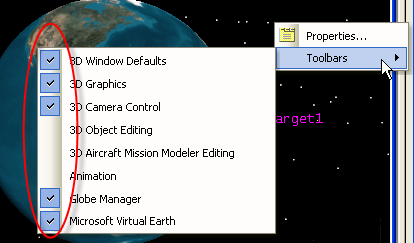Using STK Toolbars
STK has many toolbars to help you perform common tasks quickly.
The STK toolbar system is designed for usability, flexibility, and easy customization. Toolbars specific to a particular window are located on that window, giving you quick access to features relevant to the window. For more information on what you can do with toolbars, see the sections in this topic:
Customize quickly
For the STK application and certain windows (e.g., 3D Graphics), you can do the following:
- Choose to show or hide whole toolbar panels
- Add and remove individual tool buttons on a specific toolbar panel
Clicking a toolbar's Options button (down arrow) gives you quick access to all of these options. Selecting Toolbars from the View menu enables you to show or hide panels.
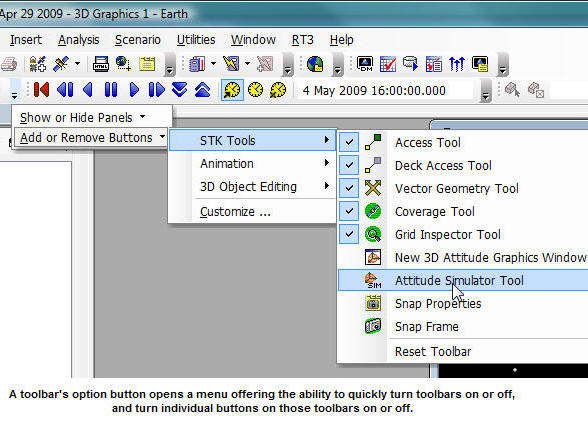
In addition, from both the Options button and View menu > Toolbars, you can select Customize..., which opens a dialog box for adjusting your toolbar and menu configurations.
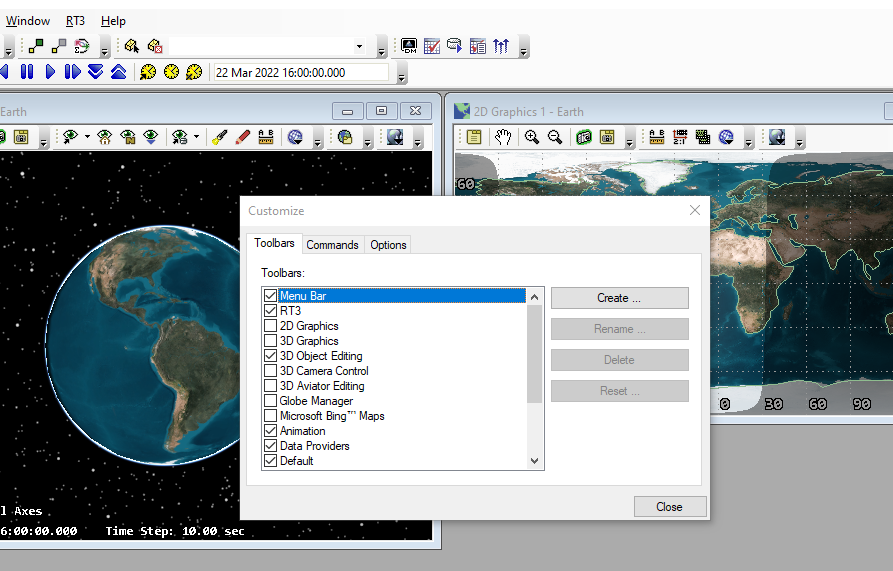
Use the Customize dialog box to perform the following customization functions:
| Customizing function | Method |
|---|---|
|
Move a tool button from one toolbar to another |
Using left-click and hold, drag the button from one toolbar to the other toolbar. The Customize dialog box must be open for this to work, even though you don't use it to perform the move. |
|
Copy a tool button |
Select the Command tab in the Customize dialog box. Then, in the Categories list, select the category that contains the button that you want to copy. Drag the button from the Customize window directly to the actual toolbar on the STK application. A copy will appear in the toolbar at the location where you release the mouse button. You can also copy toolbar buttons by pressing Ctrl while you drag the button from one toolbar to the other toolbar, with the Customize dialog box open. Use this "Copy a button" function to add a button to another toolbar while retaining it in the original toolbar. |
|
Remove a tool button |
Drag the button from the actual toolbar onto any empty area in STK. The Customize dialog box must be open for this to work. |
|
Create a new toolbar |
Select the Toolbars tab in the Customize dialog box. Click . Enter a name for the toolbar and click . Follow the above directions to move or copy buttons to the new toolbar. |
|
Reset a toolbar to its default state |
Select the Toolbars tab in the Customize dialog box. Select a toolbar. Click and confirm the reset by clicking in the confirmation dialog box. |
|
Delete a toolbar |
Select the Toolbars tab in the Customize dialog box. Select a toolbar and click . You cannot delete predefined toolbars |
| Select options for personalized menus and toolbars |
Select the Options tab in the Customize dialog box. The following items are available only for menus and toolbars that you create:
|
| Select options applicable to all toolbars or menus |
Select the Options tab in the Customize dialog box. The following items apply to all menus and toolbars:
|
If you are moving a button with an associated drop down menu, the following message will appear "Drop down unavailable in Customize mode."
Sometimes a drop button is not shown because it will not fit on the toolbar due to window size and current location. It also will not show up in the list of buttons that are hidden.
Automatic resizing of toolbars
If you size any window that is part of the STK workspace so that one (or more) of its toolbars would be too large to fit in that window, the toolbar(s) automatically resize, hiding buttons as needed. You can still access these buttons via the Options button.
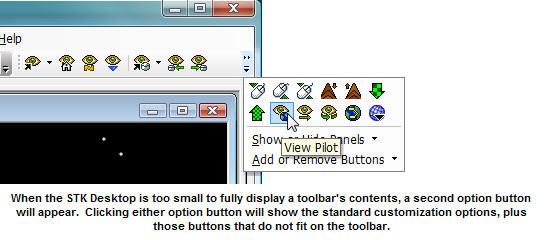
STK window toolbars
Toolbars exist on several STK windows, affording quick access to those features relevant to the window.
These toolbars are independent of the main application's toolbars in most respects, and independent of other windows having the same toolbars. So you can choose which toolbars to show on a window and which individual buttons to have on each of those toolbars, all without affecting the toolbars on the main application or other windows.
Whether a window is integrated, docked, or floating, the toolbars associated with the window always travel with it. For example, if you do most of your work in a 3D Graphics window, you can float that window and utilize its toolbars directly, while reducing the size of the rest of the STK workspace (see the figure below).
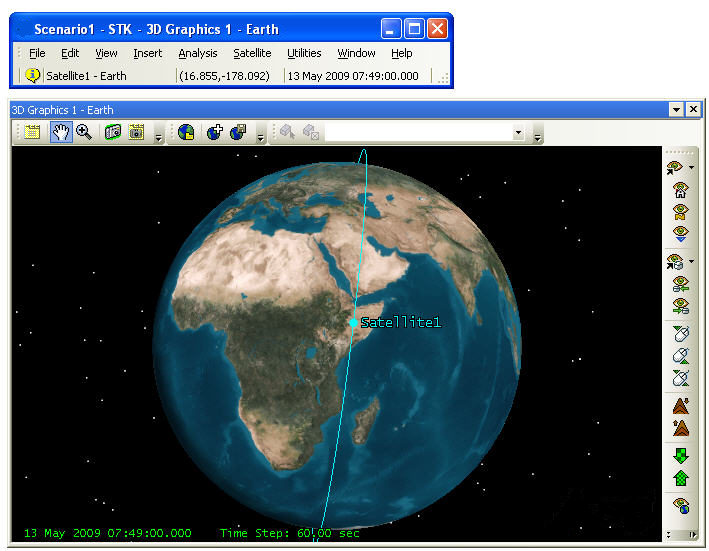
- If you drag a toolbar to redock it to another side of a window, it will only dock to the window that created it. If you float multiple toolbars with the same title, for example multiple "3D Graphics" toolbars, it may become difficult to remember which window is the "owner" of that toolbar.
- If you customized toolbars in STK prior to version 9, these customized toolbars are incompatible with later STK versions and will not be loaded.
Whenever you create a new 3D Graphics or 2D Graphics window, the toolbar layout will be the same for that type of window in the default scenario. You can change this layout and save it as the default toolbar by right-clicking the toolbar and selecting Save Toolbar Layout As Default. Then when you open subsequent graphics windows, they will have the new default toolbar layout.
Hiding and displaying toolbars
Choose one of the following ways to hide or display a toolbar in an STK window: right-click in the window and highlight Toolbars, right-click the toolbar, or click the window’s system menu, as shown in the example below.
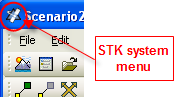
A check mark indicates that the toolbar is currently being displayed in the window, as shown in the example below. To hide a toolbar or display a hidden toolbar, click it.
